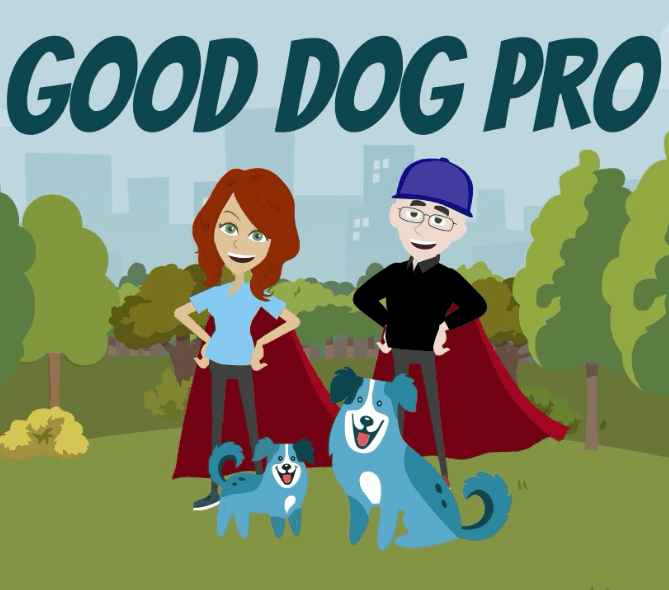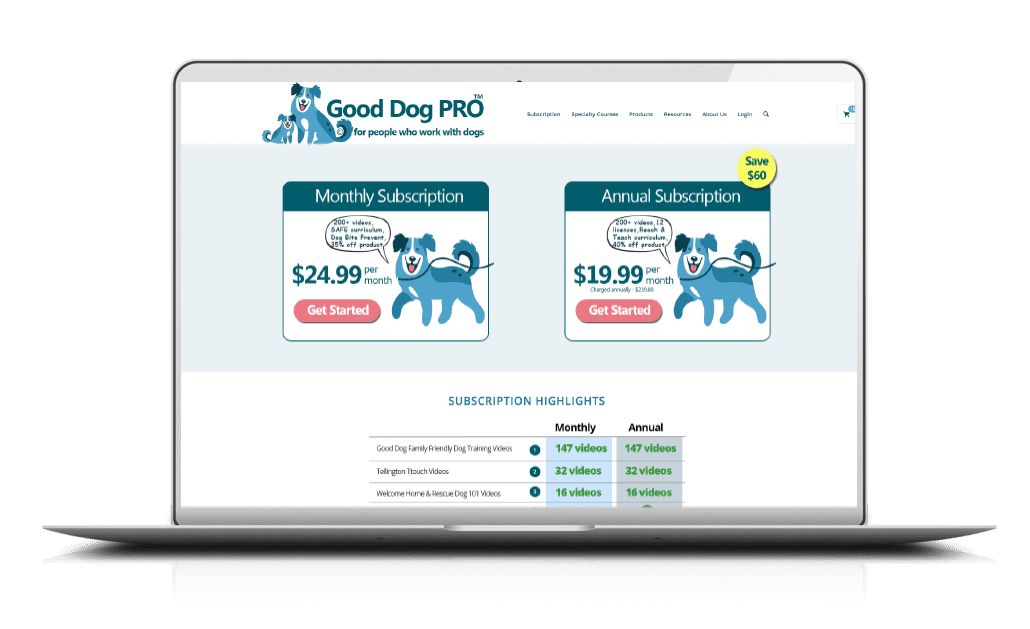This episode is eligible for the following continuing education (CE) credits:
To earn continuing education credits you must be a member of Good Dog Pro and watch the full 1 hour episode of this podcast in our learning management system. Sign up for Good Dog Pro and start earning continuing education credits today.
Announcer: Welcome to Good Dog Pro, the weekly video podcast that’s all about having a good dog without using fear or pain. Hosted by Drayton Michaels, CTC, Pitbull guru and founder of Urban Dogs and ModernDogTraining.com; and Kim Merritt, co-founder of GoodDogInABox.com and GoodDogPro.com, and founder of The URL Doctor. This episode is brought to you by GoodDogInABox.com, reward-based dog training and dog bite prevention products for families with kids and dogs. Gooddogpro.Com, the online content subscription and community for dog professionals with reward-based dog training products, curriculums and online courses to educate, motivate, and positively impact those that work with dogs. And ModernDogTraining.com, remote consulting for you and your dog with Drayton Michaels. Now let’s join Good Dog Pro.
Kim: Hi everyone, and welcome to the Good Dog Pro video podcast, where we discuss and debate dog training without fear and pain. I’m Kim Merritt co-founder of Good Dog In A Box, and I want to welcome my co-host today, Drayton Michaels. Hey Drayton, how are you?
Drayton: How are you? I’m doing well, Kim, thanks for having me.
Kim: Absolutely. So our subject today, general impulse control and stress reduction for all dogs. And let’s face it, if we’re reducing the stress in our dogs, we’re probably also reducing the stress in our own lives. How could that be bad? So let’s start with schedules. Why does a dog owner want to be concerned about a schedule for their dog? We schedule everything in our lives. Our kids are on schedules. Why do we, why do we need to schedule the dog?
Drayton: It seems kind of weird, right? You know you’re going to feed your dog, and walk your dog, and that might be on a schedule, but even that can get up ended, right? So let’s say you have an emergency with your children, or there’s weather that impedes something. It’s just a really good idea to make sure that when you sit down and do your scheduling, because most people schedule stuff throughout the week that you, you make sure your dog gets to that play date or you really make sure that you get that three o’clock walk and you don’t just let the dog in the backyard. So let’s do some quick math. Most dogs, and again, I’m not talking about dogs who live in really rural areas and things like that. I’m talking about people who live nine-to-five lives in the suburbs and urban areas. Eight hours of sleep, eight hours at work, that’s 16 hours of your day that your dog is inside. Most dogs, 23 to 22 hours a day, they’re indoors. And they have to be, because it’s not humane. Leaving dogs outside is not safe, but we’re outside. It’s a big deal. And if they miss that walk because of weather or they miss something, if you have things scheduled in for your dog each week, with those little impediments that come into your schedule, things can fall through the cracks. Especially people who have a backyard. A lot of times the dog just goes in the backyard, and it might be great and it might have an awesome time back there. But again, winter comes through, rainy seasons, things like that. So when you have a schedule and you’re just focused every day or every week on making sure you meet your dog’s needs. This is crucial. They get a chance to play, socialize with friends, maybe go on outings, work-to-eat toys, all this stuff is a cumulative approach to making sure that every day your dog is going to have less stress. Because that’s the real underlying cause for a lot of the issues that people end up having with dogs, whether it’s general impulse control issues. It bleeds into some sort of fear, anxiety, and aggression type stuff because dogs are just not getting enough of the things that they need.
Kim: So for a dog owner, how do they know what’s enough? What’s too much? How do you gauge that?
Drayton: Well, every dog is different, every lifestyle is different. Some dogs have athletic needs, some dogs have more social needs. All dogs need socialization with humans and dog friends, things of that nature. But it really boils down to the dog. If you have an eight month old dog who’s really energetic and has a lot of energy and is just a high energy type dog, then you definitely want to help your dog get that stuff out legally every day because you’re going to run into problems. You might have more of a laborious breed, maybe you have a large breed dog and they’re not really athletic. They still want to go out and smell, they might like to play tugs, they might need extra work-to-eat toys and puzzle toys. All that stuff again cumulatively adds up to you have a dog who’s going to feel better. Now if your dog has any sort of fear or stress or anxiety issues, and socializing and generally going throughout the day with them is challenging, it’s crucial to help them with those issues proactively, whether it’s with stress reduction or counterconditioning, things of that nature. When you’re proactive and you see over time and sometimes you get dramatic results if you get the right combination of stuff, you can really help your dogs regardless of where they’re at in their life, regardless of their age, their breed, et cetera. Being proactive and helping them meet their needs every day. That’s how you have a really healthy dog and really sound dog.
Kim: So we’re all busy, some of us are lucky enough to work at home, but a lot of people work out of the home and can’t get home at lunchtime. So what do you say to somebody who’s got a nine-to-five job that’s elsewhere, and they can’t get home during that time to be with or tend to their dog? How can they still keep a dog on a schedule?
Drayton: Well, if it’s in your budget, you can always have a dog walker come in or have a trusted friend or family member or a neighbor stop by. A lot of times a 10- or 15-minute walk around the neighborhood with some treats for training and getting to gather scent, go to the bathroom, and then you bring the dog back in. They go to their gated area or a crate, or if they can just be free in the house, awesome. You give them a work-to-eat toy and then they worked on that for 15, 20 minutes. That’s going to do a lot better than if they don’t have that break. If they can’t get it, okay, that’s understandable. Then just make sure when you get home and you do have the time that you schedule it in. Look, we’re all busy, we’re all tired, we all have a hundred things. One of the things you have to understand is dogs don’t understand anything about the 21st century. They’re still animals that want to do things that are intrinsic to them. Run, chase to tug, socialize with dogs, smell, dig, all that stuff. That’s what dogs want to do, so we’ve got to work it in. And honestly, it’s really a good stress buster for us, because if you’re out there having a good time with your dog, you’re not worried about stuff. You’re not really thinking about things. You’re just focused on your dog, and that’s why we get dogs, for companionship because we love them. They make us feel good. And a lot of times, and I see this because I work with a lot of different dynamics, people love their dog, but the main reason why they’re calling me is they have forgotten to give their dog their needs daily. It’s reserved. Sundays they bring them to the farmer’s market. What about Monday through Saturday? The dog is going in the backyard for 10 minutes, coming in, they might get a walk, maybe they’re getting worked-to-eat toys sometimes. What about every night? But that’s what I mean. Good people can just have their dogs fall through the cracks. And then, the next thing you know, the dog has these behavior issues that are usually related to stress.
Kim: So is this something that has to be a rigid schedule? Do we need to stay flexible?
Drayton: Staying flexible is good, and when you get ahead of stuff you understand if you can get your dog out to the backyard every night between 6:30 and 7 for a rip-and-run with some fetch and tug and all that may bring the kids out there with them, then give them a quick walk around the block for 15 minutes. That 45 minutes is going to give you so much benefit when you get back and you want to sit down with your family or you just want to relax. So you’ve got to put the time in, dogs are work. I always say roughly 30 hours a week to do it, that’s the minimum. If you want to look at it like staying flexible or rigid, the way I look at it is you want to stay flexible with your criteria of what you ask the dog for. As far as your schedule, most people are giving their dogs scheduled things. What I’m saying is schedule extra, really make sure they eat out of work-to-eat toys. Because again, if you give your dog a work-to-eat toy that takes 20 minutes, if you do that three times a day, that’s almost an hour where you’re providing mental stimulation, they’re doing stuff that’s going to have a cumulative effect. And when I say “stay flexible,” I mean physically. You have to be in shape for certain dogs, dogs are physicalities. That’s what you have to do. You have to bend, you have to move, you have to interact with them in a physical way, and that’s another benefit. So everybody, no matter who you are, you need to stay active. You’ve got to stay healthy. Nobody should be living a sedentary life. No one. That’s the thing that will kill you. You have to move, connected to your breath, all that stuff. Get out, get fresh air, dogs are the number one motivation for people to not sit on their butt and to go exercise a little bit and enjoy it and socialize and get out. So don’t just let your dog fall through the cracks, that’s what today’s podcast is all about. Really think about it because it goes by quick and one day you can’t really walk them, they can’t run because now they’re 13 and they’re really limited. I just made a post about when you’re saying goodbye to your dog, you don’t want to say, “I wish I walked you more.” “I wish I took you to the beach more.” You don’t want to say that when you’re crying and your dog is breathing their last breath. You want to say, “I gave you every damn thing I had buddy. I gave it all to you.” And that’s really what the crux of this is about, that’s the motivation for me to be on this sort of, “Hey, schedule your dog, be aware that time goes quick.” The joke here in Jersey is we get about two months a year where it’s perfect weather to walk your dog and those two months are not in a row. Three days here, five hours there, and depending on the time of the year it might be amazing from like six to noon and then from noon to midnight, it’s just a downpour. And everybody deals with that, so that’s why it’s crucial. We’re going to talk about some ways to make sure you know when the weather or schedule does offend you, that you can still help your dog meet their needs.
Kim: So what happens when it’s snowing? When it’s raining, when it’s crappy weather and you can’t go outside?
Drayton: Weather is always a problem at some point for taking dogs outside. So chewing and dissection, stress busters extraordinary. I have some examples here. Here is a toy by a company called West Paul. This is their tux toy. See this little hole right here. If you fill that with quality wet dog food, or you could freeze some meat in there, tuna fish, that’s about a 10- 15-minute time expenditure. So if you give your dogs three of these for dinner, depending on how the size of your dog, dinner and breakfast could be an hour, 45 minutes. Another one of my favorite toys is the Planet Dog Orbi. They have a few different models, but I like this particular one. It has this reservoir here and a nice little cone shape. You can put dry food in here, dehydrated, raw kibble, even pieces of meat. You could do combos. I would give this to my dog about six times a day. It would take my dog roughly 10 minutes a shot. That’s an hour a day. Another is bully sticks dehydrated beef chews, this is another West Paul tux toy. I always put my bully sticks in toys so that the last few inches are more challenging for the dog to get out and swallow. But again, bully sticks are a great stress buster. Dogs sitting there chewing. Remember, chewing reduces stress And here’s a new thing I’ve been using with some dogs, a little dental type chew. So all these things that are on the market for dogs to pull stuff out of, eat, and chew. If it’s healthy and it doesn’t have any issues with your digestion or teeth or any of that, feed your dog out to work-to-eat toys. My first dog, he didn’t eat out of a bowl for about five years, from when he was about 5 to 10. That five year span is when I would strategically feed. So chewing and dissection and strategic feeding. Let me give you an example. Your guests are coming at 7, but your dogs eat at 6. Don’t feed your dogs at 6. Give them a little appetizer to keep them sane. But at five minutes to 7, call your people and say you don’t ring or knock. You have your dog go to their gated area. You give them the first frozen Kong. If the dog doesn’t have any fear or stress issues, they’re just happy go lucky pups, they’re going to maybe bark or be a little attentive to the people, and then they’re going to go right back to their food because they’re an hour late on dinner. Offer them work for food, work to eat their food. A vast majority of animals take the work, that’s how animal brains are programed: work for food. So it taps right in and it doesn’t take us humans very much time to prepare it, and then dogs get a huge benefit.
Kim: So feed every meal out of a toy?
Drayton: Pretty much. When you’re a professional, you’ve got to explain to people this is how dogs prefer to eat. Well, we have this romantic notion of tearing the bag and listening to the kibble hit the bowl, this whole thing. This whole romantic notion that’s been drilled into us. I’d rather take two Kongs out of a freezer, throw them on the floor and, “Here you go buddy, go have your dinner,” and let and let the dog roll around with the food for an hour. And if it’s going to be messy, have you dog do it in the crate. That’s a really, really good way to help your dogs every day, regardless of what else is going on in their life. If they’re eating breakfast and dinner in work-to-eat toys and it takes them on average an hour to do it, whether you parse it out dry and you keep filling it or you give them frozen Kongs, you’re looking at two hours a day of your dog doing work and you didn’t have to do really anything. I think that’s phenomenal. That’s right up my alley.
Kim: So what’s another stress buster that a dog owner can work on to occupy their dog and relieve stress?
Drayton: Well, one of the things that people really have to understand is that when you’re out on a walk with your dog, it’s the dogs walk, that is not your walk. Sorry people, if you want to go power walk and jog and all that and you want to bring your dog and they can do it, meaning they’re not going to have any issues with it. Great. Do a good five minute walk and stretch and breathing and all that and let your dog get a bunch of scent before you go run in with him. But generally you should be out there allowing your dog to gather as much scent as possible. Because dogs that gather scent are less stressed. They’re going to have a lot of mental stimulation derived from gathering that scent. And you know, a lot of people have this really antiquated notion that the dog has to walk by their side, and that’s not true. Now is a heel good? It sure is, but not all the time. I might need it in the vet office or I might need it on a tight sidewalk. But generally I think you should just let dogs gather scent. He’s pulling? No he’s not. You’re walking too slow. Move quicker. Hustle up to that. You know why? We just talked about it, most dogs spend 22-23 hours a day in a house, and I have them outside for 15-20 minute walk. Not everybody is walking their dog for two hours a day, the average person is walking their dogs from 10 to 20 minutes, maybe 30. That’s it. I know, I work with 400 dogs a year and most people are walking their dogs every day. They’re constitutional walk two or three times a day. 10 to 20 minutes. So when they’re out there, it is a huge deal. It is massive to them to smell that pole, to smell that tree. Where did that dog pee? All that stuff is massive to them. So when I see people pulling their dogs around and not letting them smell, it breaks my heart because it’s kind of like taking a goldfish out of the water and going, “Haha,” put it back in. No, it’s not cool, that goldfish is having a lot of stress because you just took it out of the water and put it back in. Well, we don’t let a dog smell when you pull him off the smell and you’re just walking, they’re stressed. And there’s a lot of subtle signs of stress people have never been educated on. So they don’t know it, they get the dog home, and they think he’s fine because he pooped and peed. But I’ve walked those dogs and when people go, “Wow, he really settled in for you after like three minutes.” I’m like, yeah, because like counter condition, I’m not busting his chops. I’m letting him smell. I’m hustling for him. I’m letting the dog walk. I call the way I walk dogs “controlled freedom.” Some people think I walk dogs like a drug detection officer, but that’s just because I keep my head in the game and I’m looking around. I don’t sleep. There’s a lot going on where I walk dogs, a lot can happen in a blink of an eye. So I pay attention. If you let your dog gather scent, they will do much better on a leash walk. And I realize you can’t stay at the fire hydrant all day, so give your dog a good three, four, maybe five seconds if you have to move on, and treat them. Most people will do the same walk, right? They have the same few areas that they walk in. So if you’re at the hydrant and you know your dog is going to want this row of trees, just, “Come on buddy. Let’s go.” And then get them to the row of trees because you know they’re going to go there. So use that as the reinforcer to get off the hydrant, for example, and move on. So you can use scent to just move down as well. You know, just move down along your walk.
Kim: And how much of that walk should be devoted to letting them kind of do their scent thing versus whole walk?
Drayton: The whole walk. I know where I’m going, I know how to get home, I’m not worried about it. The more the dog’s head is on the ground gathering scent, the easier it is for me to go, “All right, what’s going on out here? Is there a skateboard coming? That dog just barked, where is he?” People have to realize that when dogs are on leash, especially a collar, but a harness as well, they don’t have flight response. Fight, flight, freeze. That’s the classic three responses. So they can freeze on leash, they can freeze up and they can fight, but they can’t flee and they know it. Dogs know they do not have full range of motion that they are contained just like any creature would. So there’s a lot of little stresses I equated to driving. You might not be stressed the whole time you’re driving, but I guarantee you at some point and everybody’s day are like, “What am I doing in this car? I can’t wait to get out of this car.” So there are a lot of little and sometimes big moments on leash where dogs get really stressed and flummoxed and the vast majority of people are not being educated on counter conditioning, which reduces stress and allowing dogs to gather scent, which reduces stress on proper leash mechanics. So people aren’t causing stresses by pulling on dogs, but when you factor all that in and you look at a dog being walked on leash and you understand all that, and people don’t know what they’re doing. It’s really sad and it gives a new perspective on how much respect we should have for dogs because, you know, when you think about how many dogs don’t get to gather scent and really don’t get to walk or get pulled around and not really like respected, your heart starts breaking and you start saying yourself,”Yeah man, I gotta do something about it, I’ve got to educate my friends and family.” If you’re not a pro or if you’re a pro, like, you know, that’s what kicks me in about every morning. Like there’s a lot of dogs out here who are getting misunderstood and a lot of people who lack skill and knowledge. So I got to get on my game.
Kim: That’s what I see the most around my neighborhood when I walk are people walking their dogs, but just pulling the poor dogs when they smell.
Drayton: And that’s because there are people out here telling people to do that. Because of TV shows and other dog trainers out here who don’t understand what I’m talking about. Or if they do, they don’t care because I don’t understand how you can know all this, right? Like if you’re a professional and you have clients, you should have a really good understanding of scent. What a lot of people don’t get told is there is a sequence called search decide track and all dogs have it in the search part of the sequence. The dog looks kind of confused, and then they decide and then they track. And if you tap into that and you help them search, decide, track, they’re gonna have a lot less stress. But the problem is people have been sold this really antiquated notion that you have to walk your dog, like you’re in some sort of competition and they have to be by your side. And if they stop to do anything, they’re just obeying you. And it’s like this whole idea of control is ridiculous. What you need to do is teach your dog that they can control their environment about 99% of the time, and they can’t. And that’s how I go about with dogs on leash. Like you can do whatever you want as long as you can do it right. You can’t eat trash, you can’t step in the street, can’t jump on people. Right? You can’t pull me down the street like a sled. I’m going to stop, start like, you know what I mean? Like there’s, there’s rules here, but you can do what you need to buddy. It’s your time out. This is walk number two, right? And I’m only out here for 20 minutes. So mazal Tov, man. Disneyland. Let’s do a kid. Whatever you need to do. That’s how I approach walking my dog or my client’s dogs when I have the privilege of walking my client’s dogs, my heads in the game and paying attention and I’m letting the dog beads off.
Kim: So you’ve mentioned counterconditioning a couple of times. Let’s talk about that. Explain exactly what you mean and how does one go about doing that with their dog?
Drayton: Well, you can go to the urban dog’s YouTube channel and check out all the videos on counter conditioning. I have a general educational video about it, the most popular video on the channel, so you’ll be able to find it right away. Counter conditioning is pairing stressful, fearful, weird, startling events. Pairing those with a high value food reward. So you’re out walking your dog and they go, huh. And they don’t care what it is. Traffic, humans or dogs when they go, huh, even a sound. Yes. And treat them. Yes. Like you know, like a clicker, a marker and Mark that moment and you pay him. And what you get is you get a dog who has less stress associated with sudden environmental contrast. And what you also get is an auto disengage. So in time the dog’s going to go, huh, pay me, and they’re going to start to bounce off this stuff and look back. Or they’ll bounce off the marker or you’ll go, yes, and they’ll hear that yes, and they’ll turn around and you’ll be able to pay him for disengaging. If you do this and all dogs have stress, the dog will have less stress and if your dog does any kind of reactivity, this is going to help, right? Any distance and awareness. If it’s too close too soon too sudden it might all fall apart and you just got to play triage and just get the hell out of there because if your dog’s reacting or scared, you need to create distance. But if you have the distance in the awareness, you can get a lot of stress reduced by just marking and paying and counter conditioning. Your dog puppies need it. Every dog I’ve ever worked with has had. At some point, they’ve got some type of stress or fear or excitability even, right? Like I always tell people, if you have a dog who’s like, Oh my God, Oh my God, I love all these people. I’ve got to go see everybody, right? Because one of the things that people do with their puppy is they meet everybody, but then after awhile they’re like, Jesus, dogs socialize. I don’t want to meet everybody. So what I say is fine, don’t meet everybody. Just meet the people you want to meet back off the sidewalk, right? 10, 1520 feet and just yes, and treat your dog. And when they’re bouncing around, just hold the leash short six inches. You know what’s going to happen after two days of this, the dog’s going to realize there’s a lot less energy expended to just place my boat on the ground or stand here and take the food for these people passing their little butts. They’ll wiggle and they still love people, but all they get to get to you get to you goes away because they’re getting reinforced and they’re learning. Oh yeah, we don’t meet everybody. We only meet certain people. So you can counter condition the dog for all these things and reduce their stress, help them with their frustration. And you know, the ancillary benefit is, you know, you’re getting these behaviors like sitting in waiting and disengaging off cues just as a byproduct. You don’t really have to do much else. You just yes. And dreams. So that’s what counter is.
Kim: So any other suggestions for stress busters?
Drayton: Fetch and tug. Fetch and tug. Fetch and tug. If you have a dog who likes the faction, dogs who like to tug I think you should be doing that daily. One of the things I often tell my puppy clients when they come into orientation is look at the two sheets on fetching tug. And if your dogs have any interest in it, teach them to fetch and tug. And when I say tug, what I should really say is teach them to drop it. Because most dogs like to tug and if they like to tug, the real challenge is getting them to drop it. But fetch and tug and teaching a dog to drop something when they’re tugging is easy. And here it is short duration. So dog gets purchased 1001, 1000 to release that pressure, put food on the dog’s nose and say drop it when they drop it, removed the rope, give the dog the food, keep the rope away. Going to behavior like a set or a weight reconvene the tug. At some point you’re going to come around by halfway with the food. The is going to drop it cause they’re going to expect the food, right? They’re gonna know what’s coming. So then you can start to use tug as your reinforcer, drop it, dog drops it, boom. Take it. If you have a dog who can play tug by taking it and dropping it. Okay. And what I’m going to say next, I really mean this. The average person should not have their dog tugging on something for more than 10 seconds before they get a drop it. And the reason is, is tugging, is self reinforcing. And the most important thing about tug is the dog learns to drop it. Because you know, if you’re at a barbecue or out somewhere and your dog grabs something and you go drop it, guess what? They’re gonna be much more likely to pop their jaw open and drop it because they didn’t play in tug daily or weekly, whatever. And they’re learning vacuum to drop it. It’s snowing, it’s raining, it’s hot. Seven to 10 minutes, a tug you can get sit, drop it, take it, leave it touchdown weight. You can get all those while you’re playing tog okay, same FACHE, right? So you have a dog who’s playing fetch and tug every day, 10 minutes here, 15 minutes there, seven minutes here, you’re going to have a dog who’s got a a lot less stress and they’re going to probably be really well trained because, and again, my favorite way to train dogs is with play. People think, Oh you use food. Yeah, I use food all the time. Dogs got to eat. I know how to use food, but my favorite way to train dogs is with like balls and robes and dog toys and drop it and leave it and all that. And running around like I’m a seven year old kid. Like that’s my favorite way to train dogs is just go nuts in a yard or a basement and just leave it, take it and just have fun, you know? And that’s the other side of this Lake. We’re talking about reducing stress for people. I mean for dogs, but the, the ancillary benefit is if you enjoy this and you should, you’re gonna feel a lot better after that, you know, 20, 30 minutes, 10 minutes, you know, with your dog doing stuff that they like. I like making dogs happy. It makes me happy. I’ll be really honest. Like I, I like to make dogs happy.
Kim: Well, and I mean, isn’t that the point is in the end for everybody to feel good. I mean, again, that’s why we have dogs because they make us feel good and if we’re not playing with them and enjoying them and getting outside with them, what’s the point? So it’s just, it’s a self fulfilling thing. If we’re making the dogs happy, we’re going to be healthy, healthier, and happier in the process as well. And I think that that’s just great advice. So we’re, we’re down to our last minute. You want to give us a quick wrap up then of what we want to do to keep our dogs less stressed.
Drayton: Stay engaged in your dog’s life every day. Put it on schedule, make sure they’ve got chewing and dissection options that are legal. Make sure they’re going out to places that they like to go to. Go to dog friends houses and walks with their buddies, play times. Allow them to gather scent. Make sure that you’re out there counterconditioning fear and stress so that they’re feeling less stress, even frustration and you know, excitable moments can be counterconditioning. If you’re doing all this, you’re getting ahead of stuff. You’ve got your weather app, you know it’s going to rain, so you get that walk in early. All of these things. If you do this, you will have a much less stressed dog and a better train dog because you’re going to be proactive every day communicating with your dog and helping them learn how life works. They’re not just laying around and going in the yard here and there and going for a walk now and then it’s every single day they’re getting their needs met and that’s always gonna help.
Kim: Awesome advice straight and thank you so much for sharing with everyone general impulse control and stress reduction for your dog. We are going to continue into the second half of this on GoodDogPro.com for our professional trainers if with, for those that have a subscription. So please join us there and we’re going to talk more about this great subject and we’ll see everyone else next week. Thank you so much.
Drayton: Take care. Thanks again.
Announcer: If you’d like to participate in the rest of today’s conversation for professionals who work with dogs and receive continuing education credits from participating organizations for listening, visit GoodDogPro.com And subscribe today. Use coupon DOGS ROCK to get 40% off your first month or annual subscription.
Drayton Michaels has been working with dogs professionally for over twelve years. In 2007, he earned his Certification in Dog Training and Behavior Counseling from the San Francisco SPCA Academy for Dog Trainers, directed by the renowned authors and dog experts Jean Donaldson and Janis Bradley. Drayton offers a specialty subsidiary of his Urban Dawgs, called Pit Bull Guru, and offers reward-based training and behavior consulting through ModernDogTraining.com. Drayton is the producer of The Pit Bull Hoax, a short film that set out to debunk common myths about Pit Bulls. His two YouTube Channels, Pit Bull Guru and Urban Dawgs have over 300,000 views.
Kim Merritt is a serial entrepreneur who started her first company, Kim’s Khocolate, at eleven years of age. As a teenager, she was discovered by Guy Kawasaki who invited her to make custom Khocolate for Apple. Kim went on to do business with The Rolling Stones, AT&T, MCI, Becton Dickinson, Bausch & Lomb, and Range Rover. Her second company, an e-commerce play, sold brand name dinnerware and home decor items across North America. She founded Good Dog in a Box with her sister, professional dog trainer Jenn Merritt, CPDT-KA. Her love of dogs and kids has pushed her to develop and co-develop a number of products, online training courses, and curriculums revolving around dog bite prevention and dog safety. Her latest endeavor, Good Dog Pro, is a subscription based online education system and community for dog professionals.
Subscribe to Good Dog Pro for Full Access To Our Video Podcasts
Good Dog Pro members get full access to both our video podcasts, plus 200+ reward based training videos, dog bite prevention and humane education curriculums, discounts of up to 75% off Good Dog products and courses, webinars, and so much more!











Leave a Reply
Want to join the discussion?Feel free to contribute!